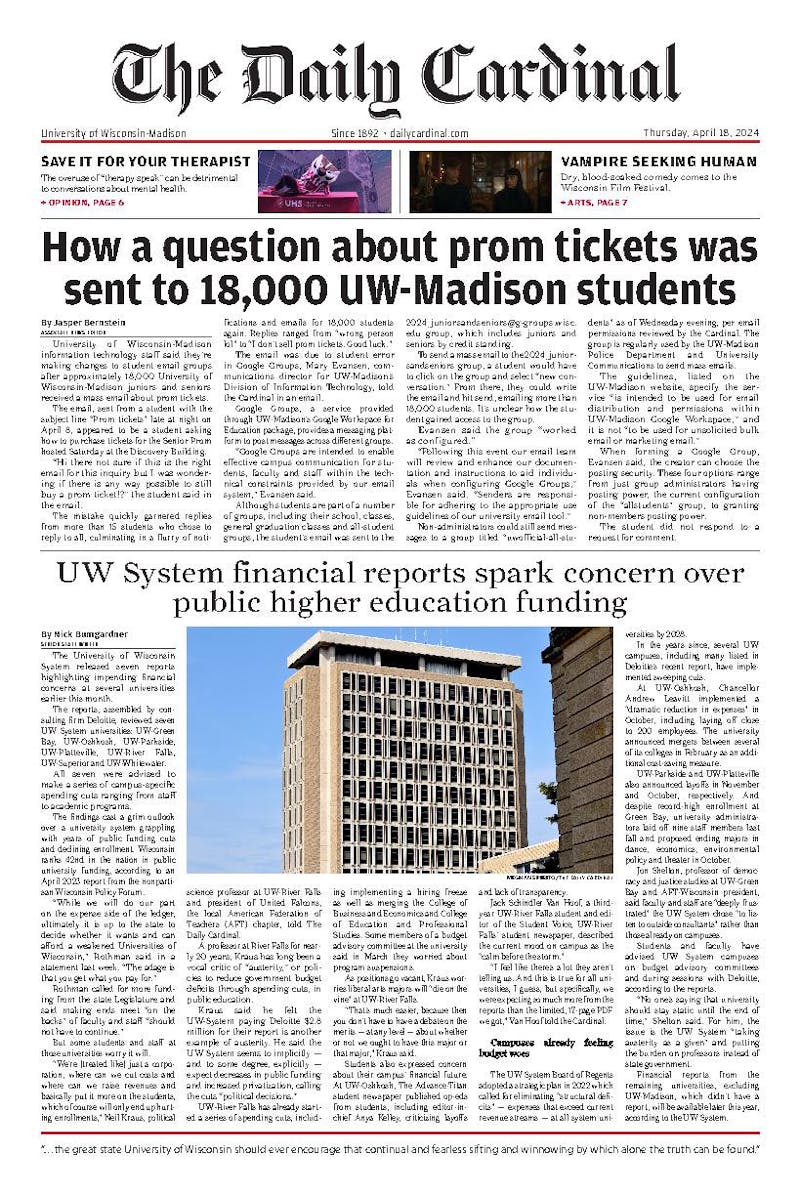For first-year student Melissa Strupp, the struggle to start her college career began long before she ever scaled Bascom Hill.
“I had to apply for a lot of scholarships, as well as financial aid to help cover some of the costs, but I also have been working since my sophomore year of high school to start saving for college,” said Strupp.
It’s no surprise that students scramble to pay tuition; the national cost of attending college is on the rise. Tuition at four-year public universities rose by 9 percent from the 2011-’12 school year to this year, according to the College Board Trends in College Pricing 2016 report.
Though Gov. Scott Walker’s recently announced tuition cuts will lower tuition by $360 per year on average for in-state students throughout the UW-System, out-of-state and professional students will pay the price, with upcoming tuition increases for both groups.
Despite the announced savings, in-state students like Strupp still struggle for daily funds.
“I've been working while in college to help pay for certain necessities that I also need. It's been hard because all the money I saved up from high school is gone in the first year,” she said.
Despite scholarships and outside help, Strupp still has to work to cover the cost of college.
“Over winter break I worked every single day to help save up money and it's definitely really stressful,” said Strupp. “Money seems to disappear really fast when you have to pay for tuition and costs of housing and all of that. I have to find a balance between working and my studies.”
According to the U.S. Census Bureau, in the 2015-’16 school year 72 percent of college students worked while in school to offset the cost and save for the future.
On the UW-Madison campus, a professor’s plan hopes to ease the burden of rising college costs.
Partnering with other researchers, UW-Madison’s La Follette School of Public Affairs professor Timothy Smeeding created a national plan to reconfigure the aid given to children in poverty, expanding opportunities for low-income children to attend college and pursue advanced degrees.
Smeeding’s plan, based on similar proposals in Canada and Europe, would increase legislative representation for children under the poverty line
Entitled “Universal Monthly Child Allowance,” the proposal distributes money directly to families in poverty, giving them $175-$300 per child each month until the child reaches 18. Children would be able to use some of the money each month to start saving for college earlier.
Utilizing funds from current child poverty legislation, Smeeding’s proposal aims to streamline aid allocation.
“We're making it explicit; we're making it monthly,” he said.
First-year UW-Madison student Caitlin Attaway sees potential in the plan. The daughter of a Madison East High School economics teacher, she has witnessed the challenges children in Madison face at school and at home.
“In general, I feel as though the tax reduction that children get doesn't really give a tangible source of money for them, because they don't really see the money coming through physically,” Attaway said.
Schools such as Madison East High School and La Follette High School lack aid for disadvantaged students, especially those hoping to attend college.
“La Follette is a failing school right now,” said Attaway. “They have a lot of lower income kids that could definitely benefit from the proposal.”
A majority of city high school students battle to get by: in 2013, the Capital Times found 56.7 percent of Madison East students and 53.8 percent of La Folette students are economically disadvantaged.
Smeeding’s proposal poses to remedy potential graduation setbacks.
“Right now [family] subsidies for kids are invisible and hidden in the tax code,” said Smeeding.
According to Strupp, the the financial maze and limited financial aid has kept many of her friends away from UW-Madison.
“I know a lot of people opted out of going to a four-year university and went to a tech school instead because of the price,” said Strupp.
According to the National Center for Education Statistics, 7.2 million students in the United States attend a two-year college, while 13.3 million go to a four-year college.
Although associate degree holders reap the short term benefits of paying less for college, they still make, on average, $500,000 less than bachelor degree holders over the course of their career, according to the Georgetown University Center on Education and the Workforce.
Still in its proposal stages, the “Universal Child Monthly Allowance” poses to subsidize adolescent education nationwide if passed, piggy-backing off the format of plans such as Social Security.
Smeeding sees his plan aiding students not only for the short-term, but also with future college savings and investment. Its implementation, however, can not begin unless the proposal becomes tangible legislation, a decision yet to be determined by Congress.






